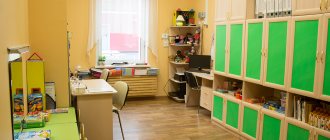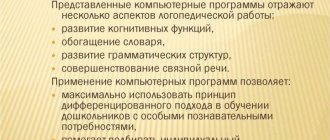The use of breathing exercises in the work of a speech therapist with children with general speech underdevelopment
Natalia Morozova
The use of breathing exercises in the work of a speech therapist with children with general speech underdevelopment
The source of the formation of speech sounds is an air stream leaving the lungs through the larynx, pharynx, oral cavity or nose to the outside. Correct speech breathing ensures normal sound production, creates conditions for maintaining normal speech volume, strictly observing pauses, maintaining fluency of speech and intonation expressiveness.
Speech breathing is the basis of sounding speech, the source of the formation of sounds and voices. It differs from non-speech (physiological breathing) in that during the speech process, after inhalation, which is carried out simultaneously through the nose and mouth, there is a pause. Speech breathing is carried out voluntarily, non-speech breathing is automatic. During the process, speech exhalation occurs mainly through the mouth, it is somewhat slower. During physiological breathing, inhalation and exhalation occur only through the nose. They are approximately the same in duration.
In children with general speech underdevelopment, we usually observe:
- small lung volume;
- weak respiratory muscles;
— uneconomical and uneven distribution of exhaled air;
- weak inhalation and exhalation, which leads to quiet speech (often observed in physically weak children, as well as timid and shy ones).
Problems that are solved in the process of correctional work on the formation of speech breathing
• Form a strong, smooth, targeted exhalation
• Prepare individual elements for sound production
• Improve clarity of diction
• Form the prosodic side of speech (this is a set of elements such as intonation, melody, pause, stress, tempo, rhythm and timbre).
Correct speech breathing ensures:
- normal functioning of the vocal apparatus;
- protects the vocal apparatus from overwork;
- helps maintain fluency of speech;
- promotes the correct use of intonation means of expression;
- promotes correct pauses.
Improper speech breathing is often:
- cause of impaired speech fluency (speech while inhaling);
- late or incorrect assimilation of certain sounds (for example, for the correct pronunciation of the sound [r] you need a strong air stream that would be able to bring the tip of the tongue into an oscillating state);
- weakening the volume of the voice, especially at the end of pronunciation of long phrases;
- in some cases, speeding up the rate of speech;
— incorrect use of intonation means of expression;
- unclear pronunciation of words (swallowing of endings).
Speech breathing can be difficult due to chronic runny nose, adenoid growths, general weakness of the body, and some cardiovascular diseases.
For full speech breathing, flexibility, elasticity, and a large volume of the breathing apparatus are required, which is achieved through training.
Requirements for performing breathing exercises:
• before starting the exercises, it is necessary to ventilate the room: the air in the room should be of medium humidity
• clothing should not restrict movement
• it is not recommended to exercise after eating
• control over the correct execution of the exercises is necessary (make sure that children do not raise their shoulders, take air through their nose, so as not to puff out their cheeks, so at the initial stage you can press them with your hands)
• exercises must be limited in time: from 30 seconds to 1.5 minutes (an hourglass can be used, as they quickly tire the child and can even cause dizziness
• it is better to practice when the child’s emotional state is balanced and the child is not tired.
To develop the power of the air stream, the following games are used in the work:
— Blow out the candle
— Games with whistles, sold in birthday kits
- Blow on a dandelion
— Inflate the balloon
— Blow through the straw into the soapy solution
— You can smear the ball with paint and draw with it, blowing from a straw
- Blow the paper off the straw
— Blow the ball out of the cup
— Games from the Mersibo website “Blow away the snowflakes,” where a child blows through a microphone on snowflakes that fly away and we see that behind them there was an object hidden that will need to be given to the character who will appear on the screen at the end of the game. The next game is “Help the mouse.” The mouse succeeds in dragging the sausage only when the child, using the power of his voice and breathing, says the word “sausage”; if the child speaks quietly and weakly, then the sausage remains in place.
— The “Seasons” manuals also contribute to the development of the strength of the air stream; it is harder to blow on threads than on rain. Weighting agents are also used: leaves and butterflies.
To develop the duration of the air stream, the following games and exercises are used.
- Blow on the turntable. The longer you blow, the longer it spins.
- Blow soap bubbles. The longer you blow, the more bubbles there are. The force here must be controlled, since if you blow hard, the bubbles will burst and will not fly away.
— Wind musical instruments: pipes, whistles, harmonicas and their analogues.
It is better to use soap bubbles outdoors, musical instruments at home, in a group and in an office, different turntables are suitable.
Games and exercises to develop the focus of the air stream.
- The game “Blow a goal into the goal”, which also develops the power of the air stream.
— Story pictures with characters on strings that the child blows on. For example, blow a butterfly off a flower, etc.
Thus, games and exercises were presented to develop the strength, duration and focus of the air stream, which are used in correctional work.
Articulation exercises for lips
Speech therapists conduct articulation gymnastics daily so that the skills developed are reinforced. Each exercise is performed 5-7 times. The articulatory pose should be held in one position for 10-15 seconds.
When selecting exercises for articulatory gymnastics, a certain sequence is followed, first simple exercises, and then complex ones. They are carried out emotionally, in a playful way. Articulation gymnasts are performed while sitting, since in this position the child’s body is not tense, the back is straight, and the arms and legs are in a calm position.
The patient must clearly see the speech therapist’s face, as well as his own face, in order to independently control the correctness of the exercises. A child and an adult should be in front of a wall mirror during articulation gymnastics. Children can use a small hand mirror. Then the speech therapist is located opposite the child, facing him.
Articulation gymnastics begins with exercises for the lips. The speech therapist talks about the upcoming exercise, using game techniques, and demonstrates its implementation. Then the child does the exercise, and the adult controls the execution.
The speech therapist monitors the quality of the movements performed by the little patient:
- accuracy;
- smoothness;
- pace;
- sustainability;
- transition from one movement to another.
He pays attention to the fact that the movements of each organ of articulation are performed symmetrically in relation to the right and left sides of the face. Otherwise, articulatory gymnastics does not achieve its goal. If the baby is unable to move, help him with a spatula.
The system of exercises for the development of articulatory motor skills includes both static exercises and exercises aimed at developing dynamic coordination of speech movements.
Children are asked to do the following lip exercises:
- smile - holding the lips in a smile, teeth are not visible;
- tube - stretching the lips forward with a long tube;
- rabbit - lips are closed, the upper lip is raised and exposes the upper incisors.
Next, perform exercises to develop lip mobility:
- tube smile - stretch the lips forward in a tube, then stretch them into a smile;
- the fish talk - clap their lips against each other (a dull sound is pronounced);
- snout - lips, elongated in a tube, move left and right and rotate in a circle.
The “dissatisfied horse” exercise is performed by speech therapists in the following way: the child easily and actively sends a stream of exhaled air to his lips until they begin to vibrate. The result is a sound similar to the snorting of a horse.
The “Fence” exercise develops the ability to hold your lips in a smile, exposing the lower and upper front teeth. The procedure for performing the exercise is as follows: smile, show your upper and lower teeth, hold your lips in this position for a count of five.
Exercises to develop mobility of the lower jaw
In speech therapy, to develop speech articulation, exercises are used that promote the development of the lower jaw. These include the “Cowardly Little Chick” exercise:
- open and close your mouth wide so that the corners of your lips extend;
- lower your jaw approximately the width of two fingers;
- The “chick” tongue sits in the nest and does not protrude.
The exercise should be performed rhythmically. Then they simulate chewing with the mouth closed and open.
To perform the “angry lion” exercise, you need to lower your jaw down, extend your tongue as far as possible towards your chin and mentally pronounce the sounds “a” or “e” on a firm attack. It is more difficult to perform the exercise with whispered pronunciation of these sounds.
The child is asked to pronounce proverbs, sayings, tongue twisters, which are full of vowel sounds that require a wide opening of the mouth:
- small but daring;
- I found a scythe on a stone;
- like the fisherman, like the fish;
- the snake has a bite, the hedgehog has a hedgehog;
- a rolling stone gathers no moss.
During the exercises, the speech therapist ensures that the lower jaw drops freely downwards, and vowel sounds are first pronounced a little emphatically.
Medical technologies in speech therapy
Biofeedback is a unique medical technology of the 21st century. It is based on the use of modern electronic equipment. The technique allows anyone to learn how to control their body and allows them to treat the following speech disorders:
- stuttering;
- speech anxiety;
- violation of the tempo of speech;
- violation of sound pronunciation (at the stage of automation of sounds and their introduction into speech);
- reading disorders.
Speech therapists use the following types of art therapy in the treatment of speech disorders:
- music therapy;
- kinesiotherapy;
- fairytale therapy;
- mnemonics;
- creative play therapy (sand therapy).
Body-oriented medical technologies used in speech therapy include stretching, relaxation exercises, and breathing exercises. Rehabilitation specialists at the Yusupov Hospital perform massage of the muscles of the peripheral speech apparatus for speech disorders. It helps to normalize muscle tone and thereby prepare the muscles to perform complex movements that are necessary when articulating sounds.
Finger massage of the palmar surfaces with stone, metal or glass multi-colored balls, clothespin massage and others are included in the rehabilitation program for patients with speech disorders. If you have a speech disorder, call the Yusupov Hospital.
Training the muscles of the pharynx and soft palate
Speech articulation is improved by exercises that strengthen the muscles of the soft palate and pharynx:
- yawning with open and closed mouth;
- yawning with a wide opening of the mouth, noisy intake of air;
- voluntary coughing;
- imitating gargling with your head thrown back.
The child can be asked to gargle with a heavy liquid (kefir, jelly, juice with pulp), swallow water in small portions (20 - 30 sips), and puff out his cheeks with his nose pinched. You can imitate whistling, moaning, mooing.




